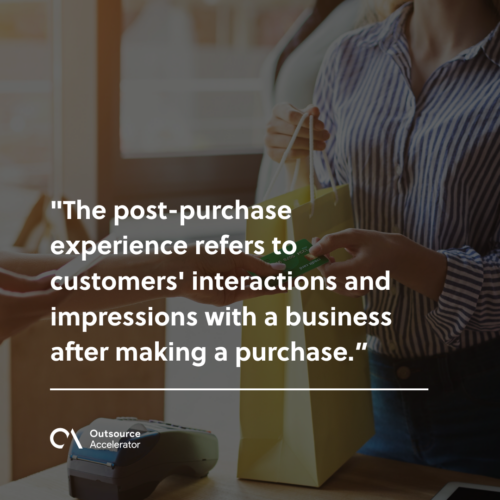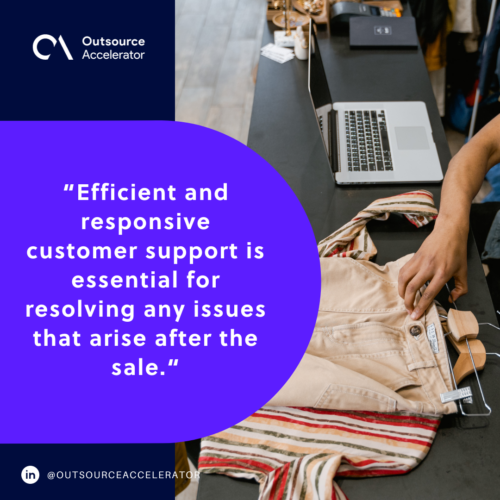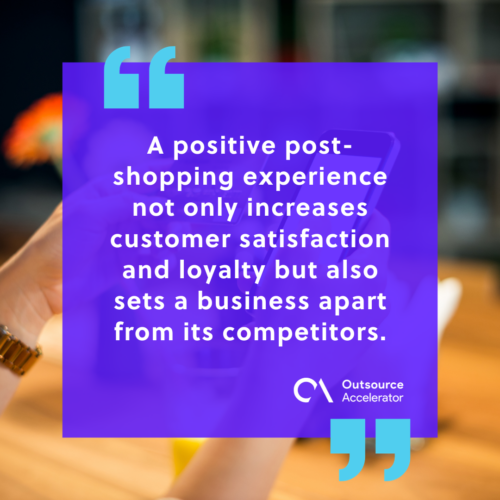Optimizing the post-purchase experience: A complete guide

In e-commerce and retail, the customer journey doesn’t end with the checkout button.
In fact, parcelLab research says that 53% of customers claim that post-purchase is the most emotional part of their shopping journey.
As such, how you plan and execute this part of the process can significantly impact customer satisfaction, retention, and your business’s bottom line.
This article explores the post-purchase experience and why paying attention to it is essential.
What is the post-purchase experience?
The post-purchase experience refers to customers’ interactions and impressions with a business after making a purchase.
The buyer’s experience goes beyond the transaction itself. Businesses must also focus on ensuring customers feel satisfied, valued, and supported throughout their journey with a brand, even after the fact.

Why is the post-purchase experience important?
The post-purchase experience shouldn’t be an afterthought. It’s a critical phase of the customer journey as it offers several advantages, such as the following:
- Customer satisfaction. A positive post-shopping experience boosts customer satisfaction. Happy customers tend to be loyal repeat purchasers who could champion your brand.
- Loyalty and retention. A seamless post-buying experience can cultivate loyalty. Content customers are inclined to come back and make extra purchases.
- Referrals and reviews. Happy customers are more inclined to leave positive reviews and refer your brand to others.
- Competitive edge. A superior post-shopping experience sets a business apart from its competitors. It becomes a differentiating factor that can attract new customers and retain existing ones.
- Reduced returns and support requests. When the post-purchase experience meets or exceeds expectations, it reduces the likelihood of returns and support inquiries.
- Revenue growth. Satisfied customers are more likely to spend more, increasing your revenue per customer.
Factors that affect the post-purchase experience
Several factors can influence the post-purchase experience:
Shipping and delivery
Delivery speed and reliability are crucial in shaping the post-purchase experience. Customers appreciate timely deliveries and are disappointed by delays or damaged packages.
Product quality
The product itself must meet or exceed the customer’s expectations. High-quality products contribute to a positive customer experience.
Packaging
Thoughtful and well-designed packaging can make a positive impression on customers. It shows attention to detail and enhances the overall brand experience.
Customer support
Efficient and responsive customer support is essential for resolving any issues that arise after the sale. The availability of multiple support channels, such as live chat, email, and phone, can enhance the post-buying experience.

Follow-up communication
Regular and personalized communication after the purchase can make customers feel valued. This can include order confirmations, shipping updates, and post-delivery follow-ups.
Returns and exchanges
Providing a simple and easy returns or exchange process contributes to a positive buyer experience. Clear return policies and hassle-free processes build trust with customers.
Surprises
Going the extra mile to surprise and delight customers can create a memorable experience. This could include a handwritten thank-you note, a discount on future purchases, or a small unexpected gift.
How to create the best post-purchase experience
Consider these strategies to create the best post-purchase experience for your customers:
1. Identify notable customer journey touchpoints
Map out the customer journey and identify key touchpoints where you can enhance the post-buying experience. This could include order confirmation emails, delivery notifications, and follow-up communication.
2. Present a great unboxing experience
Focus on creating an exceptional unboxing experience for your customers. Use high-quality and sustainable packaging that reflects your brand’s identity.
Packaging of the World data shows that 30% of businesses saw increased revenue after improving their product packaging.
You can include personalized notes or branded inserts. Consider adding surprise elements like samples or exclusive offers.
3. Provide how-to and use case content
Help customers make the most of their purchase by providing how-to guides, tutorials, and use case examples. This can be in the form of blog posts, videos, or downloadable resources.
Empowering customers with knowledge and ideas will enhance their post-purchase experience.
4. Offer rewards, referral, and loyalty programs
Implement rewards, referral, and loyalty programs to incentivize repeat purchases and advocacy. Provide exclusive discounts, early access to new products, or other perks that make customers feel valued for their loyalty.
5. Invite buyers to brand communities
Create online communities like forums or social media groups where customers can connect with each other and engage with your brand.
Inspire customers to share their stories, inquire, and offer their insights. This fosters a sense of community and deepens the post-purchase experience.
Increasing customer retention with post-purchase experience
With a highly competitive business landscape, providing a superior post-purchase experience has become more critical than ever.
It is no longer enough to simply sell a product — businesses must go above and beyond to create a memorable and satisfying customer experience after the purchase.
A positive post-shopping experience not only increases customer satisfaction and loyalty but also sets a business apart from its competitors.

By optimizing the factors we’ve mentioned, brands can foster trust, build emotional connections, and turn customers into brand advocates.
So don’t overlook the importance of the post-purchase experience — invest the time and effort to optimize it, and watch your business grow and succeed.







 Independent
Independent




